Here’s how and where to spot bald eagles through the winter in East Texas
Published 5:45 am Wednesday, November 13, 2024

- Lily pads and cypress trees in the Mill Pond Sept. 20, 2023 at Caddo Lake State Park. Caddo Lake has become a safe haven for bald eagles thanks to a partnership between the Caddo Lake Institute and Last Chance Forever.(Les Hassell/Tyler Morning Telegraph File Photo)
In 2002, country music star Aaron Tippin released the hit song “Where the Stars and Stripes and the Eagle Fly.”
That place could be East Texas, a region known for its patriotic people — and its bald eagles. And for eagle-eyed avian enthusiasts, there’s no time like the present to pursue them.
October through January is the breeding period for the remarkable raptors that reside in the region, and migratory eagles are making their way south through the Pineywoods. That means more eagles have infiltrated the area.
“This is probably the best time of year, the next three or four months, to see an eagle in this part of the state,” said Dave Holdermann, a non-game biologist with the Texas Parks & Wildlife Department in East Texas.
On eagle’s wings
Why is the bald eagle so beloved? Let us count the ways, as a poet might say.
The eagle is the national emblem of the United States, gracing our currency, the Great Seal of the United States, postage stamps and more. Known for its massive size, the elegant aviator has been a symbol of strength, power and prestige since early human history.
While there are many breeds of eagles, the bald eagle exists only in North America. It became the national symbol in 1782. The bird’s wingspan ranges from five-and-a-half to eight feet, and the birds can measure between 28 and 40 inches long. They weigh between 8 and 12 pounds, according to the Pennsylvania Game Commission.
The bird faced extinction in North America in the 20th century because of habitat destruction, illegal hunting and food contamination caused by the insecticide known as DDT, according to the U.S. Fish and Wildlife Service. The bird became an endangered species, but efforts to save it were successful. Today, it’s no longer endangered, and an estimated 316,700 lived in North America as of 2020.
Where to see them
Holdermann estimates between 50 and 60 bald eagles live in Northeast Texas. As of 2005, an estimated 160 active bald eagle nests were in Texas, but the state wildlife department hasn’t conducted surveys since then.
Bald eagles generally live near water sources, with fish, reptiles and other birds being primary elements of their diet. They tend to nest in the upper portion of mature hardwood trees, and their nests span five to six feet.
“One of the reasons we probably have as many eagles in East Texas right now as we do is because we’ve got a number of large rivers, and most of those have man-made reservoirs on them,” Holdermann said. “The reservoirs have probably enhanced their feeding habitat.”
So, where have the eagles landed in East Texas?
Holdermann recommends that people look for eagles at lakes and water reservoirs along the Red, Sulphur, Sabine, Trinity and Angelina rivers. The Big Cypress Bayou is another prime habitat, and eagles live at Caddo Lake, too. Earlier this year, park rangers at Martin Creek Lake State Park reported spotting two eagles there.
Some of the specific bodies of water where people should consider looking for eagles are Lake O’ the Pines, Lake Texoma, Wright Patman Lake, Toledo Bend Reservoir, Lake Fork and Lake Palestine. (Holdermann also said he’s seen some around Lake Tyler.)
Before looking for bald eagles, people need to familiarize themselves with the environment and set realistic expectations, Holdermann said. People should locate the access points at the bodies of water they’d like to explore.
If the U.S. Army Corps of Engineers controls the body of water, they should consider contacting staffers at that facility to get their recommendations. Aspiring “birders” also could contact the state agencies overseeing the various rivers, such as the Sabine River Authority and the Red River Authority, to ask for location recommendations.
“If you devote a day to it, that might mean going to multiple reservoirs or river areas,” Holdermann said.
Bald eagles can be spotted almost any time of day. Holdermann has seen them feeding in the mornings at Lake Tyler, but he’s not sure if that means they’re more active at any particular time of day.
Spotting the raptor
Bird-watchers should know what they’re looking for. Young bald eagles don’t look the part.
“You’re going to see probably 1,000 turkey vultures for every bald eagle,” Holdermann said. “Bald eagles don’t attain that white head and tail plumage until their fourth year. The first-year birds, the juveniles, are very dark, but they’ve basically attained the size of a full grown eagle.”
Two- and three-year-old birds may have streaks of white but remain mostly brown, Holdermann said.
“They don’t get that stark white and rich, brown colors until they’re four years old,” he said.
Bald eagles’ wings will appear almost flat, and their wingtips will curve up slightly. Other birds of prey, such as turkey vultures, have wings that point up in a V-shape, called a dihedral.
People need to know that because “you want to be able to say, ‘Yeah, I saw one,’” Holdermann said.
“This is a great birding challenge for people, and it’s a great time of year to be out,” he said. “Even for casual birders, or even someone who wants to go look for bald eagles and may not ‘bird’ much at all, to be able to say you saw a bald eagle — that’s a pretty cool thing.”
Caddo Lake provides refuge
Caddo Lake has become a safe haven for bald eagles thanks to a partnership between the Caddo Lake Institute and Last Chance Forever, a rehabilitation organization for birds of prey. Last Chance Forever nurses injured birds back to health and releases them into the wild.
“Over the last 15 years, about seven bald eagles have been released from the north shore at Potters Point into Caddo, and they just love it at Caddo, and they stay,” said Laura-Ashley Overdyke, executive director of the Caddo Lake Institute. “They’re attracting and finding mates, because we’re kind of estimating about between five and seven nesting pairs around the lake now.”
By now, most East Texans probably know that there’s another type of eagle with an affinity for Caddo Lake. Don Henley, founding member of the Eagles band, is an East Texas native and the founder of the Caddo Lake Institute, which promotes conservation of the lake.
The Eagles have a residency through March at the Sphere in Las Vegas, and they’re using footage of Caddo Lake while performing their hit song, “Seven Bridges Road.”






